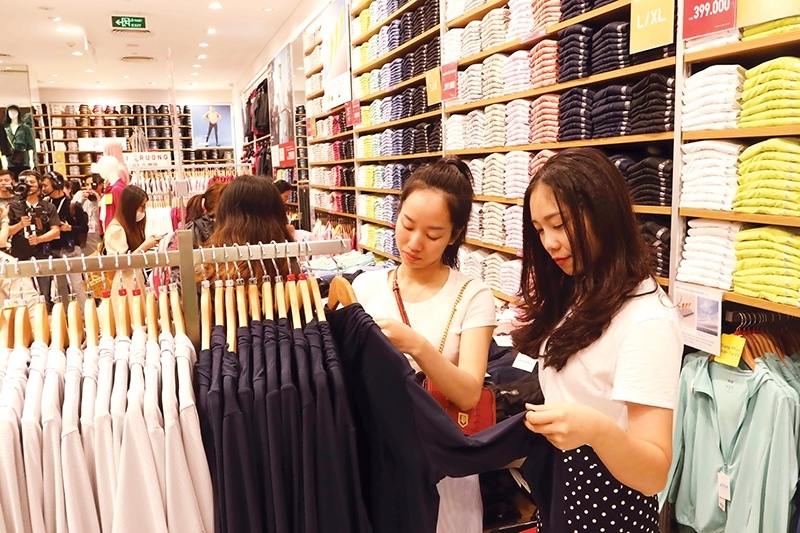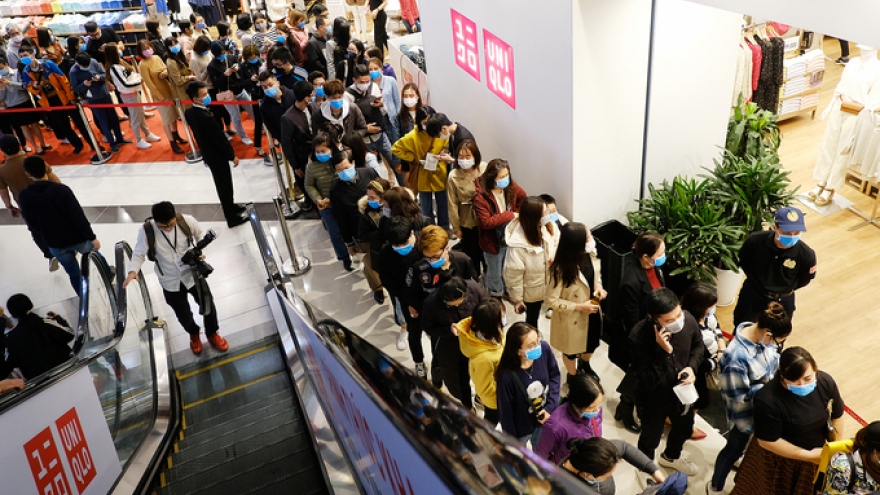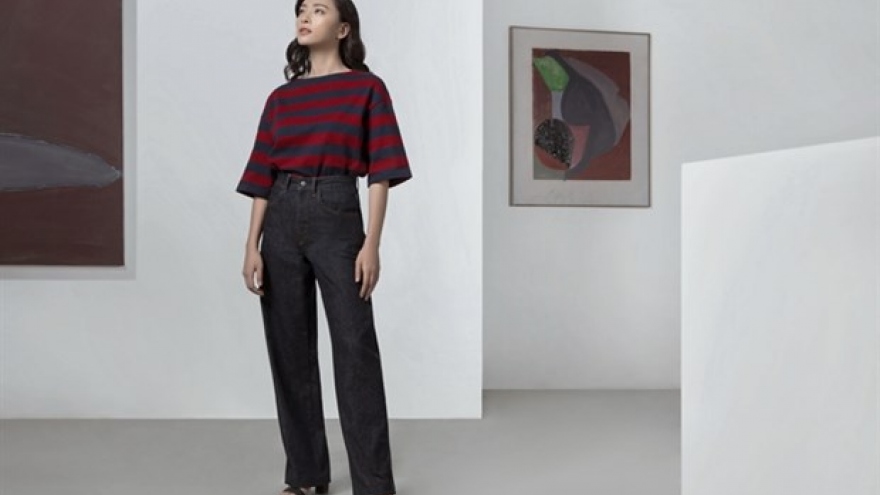Harsh reality sets in for fashion retail brands
While fashion fanatics will welcome the ever-increasing presence of international brands, the domestic consumer base has already lost a significant portion of its purchasing power amid the influence of the global health crisis on the economy, forcing domestic brands to face increased competition with new strategies to retain their business.

While most fashion brands in the world are shrinking as fashion followers have to stay away from shopping malls and stores during social restrictions caused by COVID-19, Fast Retailing Group, which owns UNIQLO, has already opened seven stores in Hanoi and Ho Chi Minh City since its first appearance at the end of 2019.
Osamu Ikezoe, general director of UNIQLO Vietnam said, “The opening of our chain’s stores in Vietnam is part of UNIQLO’s business expansion plan in Southeast Asia, based on market survey results, the economic growth rate, population size, and proportion of young people. We also have been preparing well to ensure that our new business in Vietnam runs as smooth as any other of our locations.”
Up to now, the production proportion of each UNIQLO factory around the world has remained secret, but according to Ikezoe, the company’s production is “mainly concentrated in China”, with only a small part being located in Vietnam, India, and some other countries. The general director of UNIQLO Vietnam also did not disclose the total investment in the Vietnamese market.
Changes in consumer preferences, such as from durable attire to fashionable pieces of self-expression, have pushed the fashion market in Vietnam to absorb many imported products. Foreign brands are almost not in direct competition as their directions are mostly different, focusing on diverse target groups.
However, Zara and H&M – the two brands with the earliest and most successful presence in the Vietnamese market – are still seen in some ways as rivals of UNIQLO. Spanish fashion brand Zara entered Vietnam in 2016 but has so far only sold products through its two stores in Hanoi and Ho Chi Minh City. Sweden’s H&M, which entered the Vietnamese market in 2017, has distributed products through eight stores in all major cities.
Only fashion brands with great financial potential can expand their business in Vietnam. At present, UNIQLO has a wide network of partners in Vietnam implementing its orders in the form of outsourcing.
This has also helped UNIQLO to gain advantages not only over other global competitors but also Vietnamese fashion brands. In particular, the rapid and early production in the domestic market of Vietnam allows the company to reduce costs and time, and bring in greater profits.
However, UNIQLO’s performance in Vietnam is not solely meant to provide goods to the local market but also fuel the brands’ expansion plans in other markets. At the beginning of the company’s presence in Vietnam, Tadashi Yanai, founder and president of Fast Retailing, told media that UNIQLO exports US$3 billion worth of products from Vietnam annually.
“The quality of Vietnamese-made products is high, so they are accepted worldwide. Vietnam will have an increasing presence in the global market,” Yanai added.
Thus, the goal of expanding the UNIQLO brand in Vietnam is not only making an important contribution to the sales of Fast Retailing in East and Southeast Asia but also a step to realise the company’s ambition to catapult Fast Retailing towards the number one position in the global clothing industry.
Unequal race
The pandemic and market domination through foreign brands’ retail channels, which UNIQLO is deploying the most, are pushing some of the leading Vietnamese brands such as An Phuoc, Viet Tien, Nha Be, and Garment 10 further away, and a series of major brands such as Ninomaxx, N&M, Blue Exchange, Ha Gattini, and others had to narrow their presence and change their business approach.
Even Foci, a formerly successful brand with a chain of 60 stores across the country, has disappeared after it entered the market nearly 10 years ago.
COVID-19 has been forcing many local exporters to return to the domestic market, and focus on production and sales options through domestic channels to reduce inventory, but competing with imported high-quality products is not easy. Nguyen An, general director of Garmex Saigon, said that the volume of the domestic market only accounts for 10 per cent of the company’s production, though it has linked with domestic retailers to sell their goods.
Although entering the Vietnamese market and launching a retail system is a difficult endeavour and can take a long time, factors like successful pandemic prevention and a large population still motivated UNIQLO to try conquering the market.
However, Pham Xuan Hong, general director of Saigon 3 Garment JSC, described that the situation for local brands is challenging. “Increasing the market share from 10% to 30% in the domestic market is very difficult for Vietnamese textile and garment brands,” he said.
Data from German data analyst and provider Statista shows that the size of the Vietnamese clothing market in 2019 was estimated at $5.6 billion with an expected growth rate of 8.8% per year for the 2019-2023 period.
The Vietnam Textile and Apparel Association’s (VITAS) assessment of the country’s market potential also estimates the domestic fashion consumption at around US$3.5-US$4 billion.
Fashion is inherently more than just a product keeping people covered and warm, and can also serve people’s needs of individuality, self-expression, and even spirituality.
VITAS’ chairman Vu Duc Giang is thus concerned about the market share of domestic brands amid the increasing presence of some of the world’s leading apparel retailers, such as UNIQLO and H&M, even if Vietnam is one of the top textile exporting countries in the world.
Reacting to change
Giang pointed out that the impact of many free trade agreements that Vietnam has signed in recent years is slowly showing. As import tax has decreased and the retail market opened for foreign investors and businesses, many global fashion brands such as Zara, H&M, Topshop, UNIQLO, and Old Navy have entered direct competition with Vietnamese brands, sometimes generating revenue of hundreds of millions of US dollars per year.
“Overall, the growth rate of the domestic textile and garment sector, especially that of larger corporations, is very low, sometimes even way below the set targets,” Giang said, adding that the pandemic has also made business more difficult.
As a result, the revenue of many domestic fashion brands is gradually decreasing, and marketing remains ineffective and cannot keep customers closely attached to the brands. Some companies that have reported better business results are still struggling to find new development directions, especially since their business plans have been constantly delayed by the global health crisis.
Giang said the pandemic has “changed consumer behaviour, and what they buy and how much they pay for clothing.” High-end shirts and suits have seen a lower consumption, with some businesses seeing their order reduce by 80%, if there were any to begin with.
Many businesses have had to change their production and business strategies, shifting to medium and low-end products. This transition has cost businesses a lot of money for equipment, technology, and labour re-training.
The good news is that domestic textile enterprises, for many years, have continuously invested in and boosted production of new fashion lines to supply the domestic market.
Some of them have built their brands with increasingly high product quality, reasonable prices, and a more suitable approach that meets the needs of society, while at the same time developing a nationwide distribution system.
But the weakness of Vietnam’s textile and apparel sector remains the lack of diversification in market segments and pricing.
The cycle of launching new collections, fresh looks, running ads, sharing feedback, special discounts, and cooperation with other businesses to reach new heights has become a cumbersome marketing act. For some this means that they have become somewhat passive, with a lack of creativity. Giang believed that this makes local brands lose their identity amid a market with too much competition.
The negative effects of the health crisis may last for another year or two, according to Giang. “Despite successfully controlling the spread of the pandemic several times now, local purchasing power will most likely stall in 2021, and the market share of domestic brands may continue shrinking,” he said.
Thus, domestic fashion brands do not only have to compete with other local competitors and constantly reinvent their unique selling points but also have to pay attention to the rapid development of foreign fashion brands like UNIQLO which are taking advantage of the Vietnamese market’s potential.
As the competition is fiercer than ever, fashion businesses will likely need to implement new strategies and change development directions.


